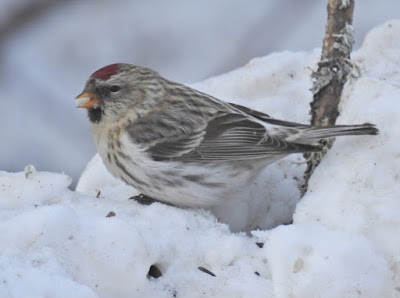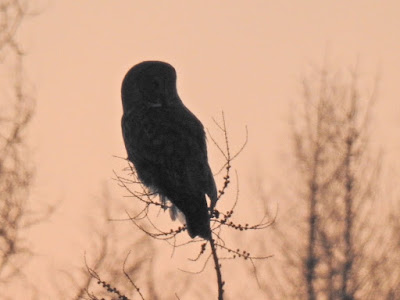 |
| White-breasted Nuthatch |
The place to see some of them is the Sax Zim Bog, a 300 square mile area of bog and boreal forest about an hour north of Duluth, Minnesota. While it hosts a myriad of neotropical migrants in the summer, the main draws arrive in the winter. This is the most accessible site to see some of the hardest to find birds in the lower 48, like Hoary Redpoll, Northern Hawk Owl, and Boreal Chickadee. While not range restricted, this is also considered one of the best places to see Great Gray Owl as well. You just have to be willing to brave potentially frigid temperatures.
 |
| Woessner Bog Walk |
Frigid turned out to be an understatement. I planned my trip for President's Day weekend, which happened to be during a polar vortex hitting the area. Lows were projected around -20, but that number inched lower and lower as my trip approached. Much to the chagrin of my family, I still decided to go.
The thermostat read -40. The coldest temperature I'd experienced prior to this was 15 degrees when I was in high school. My knees and face hurt, but the Admiral Road feeders, my first stop after searching for Great Gray Owl earlier in the morning, soon made me forget that pain. In front of me was my first lifer of the trip. There was not one, but a flock of Pine Grosbeaks, one of my more sought after birds. I looked for this stunning pink bird in Maine, Alaska, and Washington with no luck in the past. This was one of the birds that provided the inspiration to begin out of state travel, so to see these in person was an incredibly rewarding experience, and the serene snow covered ground and bright green spruce painted a perfect backdrop. I would return to the feeders multiple times throughout the weekend, and the Black-capped Chickadees, Canada Jays, and woodpeckers of the Hairy and Downy variety would never get old.
 |
| Pine Grosbeak |
After that I went to the visitor center on Owl Avenue. I heard that this was one of the best places to find Boreal Chickadee, the bird I wanted to see most (I came into the trip not expecting to see Great Gray or Northern Hawk Owl). I immediately had another lifer upon arriving- Evening Grosbeak! A massive flock was swarming the feeders, and it almost hurt me to continue on my way. The cold definitely hurt, but I have wanted to see an Evening Grosbeak for years and it felt wrong to look to look away, even though there were other birds that had to be admired.
Walking down Gray Jay Way to was one of the more scenic part of the trip. Temperatures had warmed up considerably to around -10, which makes a big difference, and the trail of packed snow was lined by snow covered spruce and tamarack trees. Even though I wasn't far from civilization I got the same rush I felt when I was in Boot Canyon in Big Bend, or when Anthony and I hiked Thorofare Ridge in Denali. The majesty of the American outdoors was on full display. My short walk ended at a collection of feeders where there was already a small group of people waiting for the chickadee to show up.
 |
| Gray Jay Way. There has to be Boreal Chickadees in those trees! |
According to Sibley, Boreal Chickadee is usually more secretive compared to other chickadees, and as a result they very rarely will go to bird feeders. Except in winter. So while they do breed in Minnesota you are way less likely to be seen in more...pleasant weather. I looked for them in Alaska without luck, so deep winter was my best bet. My fingers were quickly going numb, but after about 20 minutes we heard a call! Shortly after, a brown headed chickadee appeared- BOREAL CHICKADEE! The bird offered excellent looks for a few minutes, and the next day I was able to see it in the same spot at the suet feeder on Sunday.
 |
| Boreal Chickadee |
Before leaving I saw that a Northern Hawk Owl was being seen off of CR 7. I raced down and started scanning the tops of spruce trees. Northern Hawk Owl is extremely rare in the lower 48 even in winter (Duluth is on the far southern end of their winter range), so the opportunity to see one should not be passed up. I find owls very hard to find, but this owl luckily wasn't too hard thanks in part to its diurnal nature. A weird spec at the top of a spruce tree far off the road gave it away, and even though the views and pics weren't great you could clearly tell it was a Norther Hawk Owl! Bird of the trip so far!
 |
| Northern Hawk Owl. Sniped from a distance. |
With the afternoon winding down I walked Yellow-bellied Bog. The feeders were full of Common Redpolls, a stunning winter finch that I only briefly saw in Alaska. Desperately trying to find a mixed in Hoary, I was thankful for extended looks of an entire group! Yellow-bellied Bog was one of my favorite walks because of the trees were sunk in snow but their branches covered the trail. After the brief walk I headed back towards the Admiral Road feeders where I would spend the remaining hour of daylight, where there were more redpolls. I thought I had Hoary but after submitting it to people who know more than me it was determined to be Common. At sunset I drove up and down CR 7 checking every clearing for Great Gray Owl, and someone saw one at a great distance, and it was gone before anyone else got eyes on it.
 |
| The Common Redpoll that I really wanted to be a Hoary. There's too much streaking on the flank, though |
Sunday was more of the same so I won't go into too many details. The same birds that I saw the prior day were in the same places, although at Warren Woessner Bog I had Black-billed Magpie on a deer ribcage. Friends of Sax Zim Bog does this really cool thing where they have deer rib cages set up near the feeders, which draws in magpies, ermine, and sometimes pine martens. I've never seen that before, and it was such an interesting way to bring in other animals.
 |
| Canada Jay |
The best part of my trip was in the last hour of birding. I'm terrible at owling, and I had given up on seeing the Great Gray Owl. Only 2 groups had reported sightings in the weekend I was there, and they weren't very good looks. Oh well, even without the Great Gray I saw incredible birds. But I still drove up and down CR 7, scanning every tree in every clearing. I planned to do this for about an hour and a half, and for the first 45 minutes or so I saw nothing as the sun sank lower.
But ahead I saw a group forming on the side of the road. There are only 2 reasons for a group like that: a tour or an owl. I pulled over behind them and walked up. A guy excitedly told me that an owl had been seen but people lost it. This was my only shot, so I started scanning. I was casually pointed to a Northern Shrike at the top of a tree, the person clearly didn't know that was a lifer for me. I was so pumped because I'd missed this plenty of times, but I didn't have time to take a picture because the crowd erupted. I turned around to see the source, and my jaw hit the icy asphalt on the road.
 |
| Great Gray Owl, bird of the trip |
Up against an orange sky clear of clouds was the silhouette of a Great Gray Owl. It looked like something out of a National Geographic magazine. Towering at over 2 feet tall, this the largest North American owl, and their gray body makes them resemble a ghost. Seeing pictures of one does not do it justice, especially when it swoops low across the ground. It was extremely cooperative and stayed near the road for an extended amount of time. I pretty much stayed until you could only faintly see it in the twilight. It was one of the best birding experiences of my life, and the subzero temperatures became and afterthought as we gaped at the owl. Numb fingers aren't an issue when you're staring at a Great Gray Owl.
The Sax Zim Bog exceeded the expectations that were set as a birding Mecca. I got 7 new lifers, and each one was as outstanding as the last. The bog is a perfect way to spend a weekend birding, and you'll get to see some of most sought after birds in the country. The weather, while cold, is very manageable and should not be a deterrence. This place seems like an outstanding summer spot as well, I will for sure be coming back multiple times in multiple seasons! Between this and the Spotted Rail, the birding travels have been outstanding. Who knows what March will bring?
 |
| Canada Jay and Pine Grosbeak |
 |
| Evening Grosbeaks at Mary Lou's feeders |





